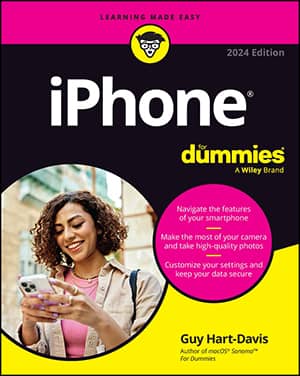If your iPhone is brand spanking new and fresh out of the box, follow these steps to walk through its initial setup, and quickly be on your way to having fun with your new device.
Turn on the iPhone or wake it if it's sleeping.
An arrow appears near the bottom of the screen, flashing messages in many languages. The English rendition says Slide to Set Up.
Swipe the Slide to Set Up arrow to the right.
The first thing you see on your shiny new (or freshly restored) iPhone is the Language Selection screen.
Tap the language you want this iPhone to use, and then tap the blue arrow near the top-right of the screen.
The Country or Region screen appears.
Tap your country or region, and then tap the blue Next button.
The Choose a Wi-Fi Network screen appears.
Tap to choose a Wi-Fi network, type a password if necessary, and tap the blue Join button. Or tap the blue Next button to skip this step.
Tapping a network name (and providing a password if needed) initiates the activation process, which requires either a Wi-Fi network or your wireless carrier's cellular network and may take up to five minutes.
If neither network is available, you'll see an alert that says you need to connect your iPhone to your computer and use iTunes to complete the activation and setup process.
After your iPhone has been activated, the Location Services screen appears.
Tap to enable or disable Location Services.
Location Services is your iPhone's way of knowing your precise geographical location. The Maps app, for example, relies on Location Services to determine where in the world you are.
You can turn Location Services on or off globally or for individual apps in Settings.
The Set Up iPhone screen appears.
Do one of the following:
If you're replacing an old iPhone with this phone: Choose either Restore from iCloud Backup or Restore from iTunes Backup to have the new iPhone restored with the settings and data from your previous one. You'll see either the iCloud Sign In screen or the Connect to iTunes screen. Follow the on-screen instructions and choose the backup from which you want to restore. In a few minutes (or more if your old iPhone contained a lot of data), your new iPhone will contain all the apps, media files, and settings from your old iPhone. You're finished.
If this is your first iPhone: You won't have any backups of your iPhone yet, so unless you want to restore it with the data from an iPod touch or iPad, choose Set Up as New iPhone. The Apple ID screen appears.
Tap Sign In with Your Apple ID, or tap Create a Free Apple ID. Then (you know) tap the blue Next button.
You can tap Skip This Step and proceed without supplying an Apple ID, but you need an Apple ID (it's free) to take advantage of the myriad excellent and free features, including iCloud.
The Terms and Conditions screen appears.
To agree to the terms and conditions, tap the blue Agree button in the lower-right corner.
A Terms and Conditions alert appears.
Tap the Agree button, and then tap the blue Next button.
What happens if you disagree? You don't want to know. And, of course, you won't be able to use your iPhone.
The iCloud screen appears.
Do one of the following:
If you want to use iCloud: Good choice! Tap Use iCloud.
If you don't want to use iCloud: Tap Don't Use iCloud.
The Find My iPhone screen appears next.
Tap Use Find My iPhone or tap Don't Use Find My iPhone.
Find My iPhone is a seriously cool feature that lets you locate and secure your iPhone if it ever gets lost or stolen.
The iMessage and FaceTime screen appears.
Tap the phone numbers and email addresses you want to use for iMessages and FaceTime calls (so that a blue check mark appears), and then tap the blue Next button.
People can use an email address or your phone number to send you iMessages and place FaceTime calls to your iPhone, respectively.
Don't sweat your decisions; you can always add and remove phone numbers and addresses in Settings, Messages.
If you have an iPhone 5s or later, the set up Touch ID screen appears (continue with Step 14); if you have an iPhone 4s, 5, or 5c, the Create a Passcode screen appears (skip to Step 15).
Those with an iPhone 5s or later, tap Set Up Now to train your iPhone to recognize your fingerprints now; tap Set Up Later to do it later.
On the iPhone 5s, 6, and 6 Plus, you can use a fingerprint instead of your passcode or Apple ID to unlock your iPhone and make purchases in the iTunes Store, App Store, and iBooks Store.
The Create a Passcode screen appears.
Enter a four-digit passcode and then enter it a second time.
The Set Up Siri screen appears.
Tap Use Siri or tap Don't Use Siri.
Siri is an intelligent and wickedly cool voice-controlled assistant.
You may not want to enable Siri if your Internet access is slow or nonexistent. If that's your choice, you'll still be able to use voice commands for dialing the phone and controlling the Music app.
The Diagnostics screen appears.
Tap either Automatically Send or Don't Send.
If you tap Automatically Send, anonymous diagnostic and usage data will be sent to Apple.
The Welcome to iPhone screen appears.
Tap Get Started to, well, get started with your iPhone.
Your iPhone's Home screen appears in all its glory.
One last thing: Apple's free iCloud wireless storage and synchronization service is strictly optional, but it's especially useful if you're planning to use your iPhone PC-free or only plan to sync it with a computer occasionally.

